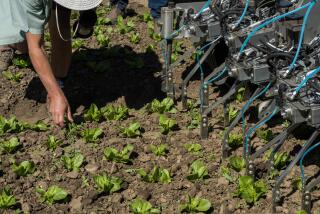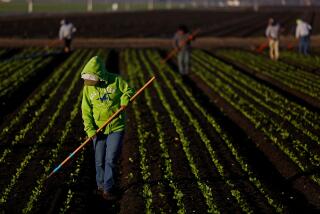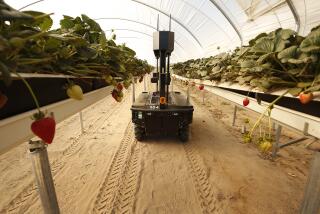Agriculture’s Example Is Food for Thought
The most productive sector of the U.S. economy is about to grow larger as U.S. farmers plant 10 million additional acres this season--a 1% increase in total acreage--even as upcoming legislation phases out crop subsidies to most of them.
Times are extraordinary in agriculture. Prices for wheat and corn are at 15-year highs, and exports of grains and food are booming. Farm exports rose 24% to $54 billion last year, and the Department of Agriculture forecasts they’ll rise to $60 billion this year.
The reason is a powerful trend of rising living standards around the world, which is pushing crop production worldwide. That has implications for investment and for technological and social change.
And it’s also a reminder of the ability of U.S. agriculture, employing only 2% of the work force, to adapt, prosper and feed the world. The complex of individual initiative and public institutions that produced such success might well be applied to many areas of today’s economy.
Asia’s growing economies are changing diets to include more meat and eggs and so creating demands for animal feed and greater varieties of food. China is importing corn to feed pigs; the spread of supermarkets in Asia makes for rising exports of fruit and vegetables as well as of Kellogg’s corn flakes and Heinz catsup. In fact, processed foods are now one-third of total U.S. exports, up from one-eighth 15 years ago.
No wonder the stock market has discovered the farm sector. The shares of Deere & Co. and Case Corp., two large farm equipment makers, have doubled in the last year. There has also been strong interest in companies that make seeds (DeKalb Genetics, Pioneer Hi-Bred), fertilizers (First Mississippi, IMC Global) and pesticides and other farm chemicals (Monsanto).
The trend will last longer than one season. Grain markets will be tight for two more years anyway because U.S. government reserves have been reduced by a bad corn crop in 1995 and growing export demand.
And strong global demand for California’s fruits, vegetables and wines, as well as for U.S. cold cuts, cheeses and frozen dinners, will continue to expand.
But a rising world demand does not presage food shortages. As prices stay high, new production will come on quickly, not only from U.S. farmers but also from those in Canada, Europe, Argentina, Australia, Ukraine and South Africa, says Robert Paarlberg, an agricultural expert who this weekend led a world food conference at Harvard that was attended by top agricultural officials from China.
So grain prices will moderate, possibly turning down next year, and food will continue to be plentiful--although some areas, particularly Africa, will need help to increase agricultural output.
Yet a striking paradox in all this success is that small, family farms will continue to decline in the face of competition from larger, better capitalized farms and from the attraction of city lights on rural young people.
“The average American farmer is 58 to 62 years of age,” notes analyst J. Blair Brumley of Dain Bosworth, a brokerage firm in Minneapolis. “The average U.S. farm is 460 acres when it might be double that for efficiency. And the average European farm is 40 acres. Consolidation is inevitable.”
So the number of U.S. farms, already down to about 1,900 from 2,440 in 1980, will continue to shrink. But production, from larger acreage and livestock operations for pork, beef and poultry, will continue to rise.
And that process is likely to be accelerated as government crop subsidies are phased out over the next seven years. The subsidies and related set-asides--paying farmers to leave land idle, thereby holding down the size of the crop--date to the 1930s, when widespread bankruptcies resulted from overproduction, drought and a protectionist trade law that, in effect, cut off foreign markets.
The idea then was to stabilize prices and safeguard farmers through regulation. But in the proposed new law, passed by the House last week, the world market is being seen as the stabilizing force--moderated in the short term by seven years of transition payments.
The legislation reflects an astounding confidence in U.S. agriculture, an industry that is really composed of 1.6 million individual business people called farmers. Only 3.2 million people in all work directly on U.S. farms. Yet production is so massive that Americans worry about being overweight and one-third of the output goes to world markets.
How did such a productive system develop? With backing for individual effort from public institutions. But the help was in the form of knowledge, not in subsidies.
In 1862, Congress passed the Land Grant College Act, a law devised by Justin Smith Morrill, an inspired Vermont farmer-legislator. It set up or gave financing to colleges to do agricultural research--among them Iowa State, Michigan State, the Universities of Minnesota and Wisconsin, Cornell and the Massachusetts Institute of Technology.
Later, in 1887 and 1914, the agricultural extension service was put in place to bring that research directly to farmers. It spread knowledge of crops and soil compounds, of seed and fertilizer and animal husbandry--and gave birth to the University of California at Riverside.
From the start it has been a highly efficient system, administered locally with funds from both federal and state governments. In addition, there has been a structure of credit help and other assistance for agriculture.
But the most important help has been knowledge. It has bred the confidence that allows farmers to plant additional acreage in response to the end of subsidies.
Indeed, as people in other industries wonder what will replace the Pentagon’s help for research and development, they might look to the land grant college and agricultural extension systems for inspiration.
And we can all hope--or is the word “fantasize”?--that the electoral process will throw up another politician with the vision of Justin Smith Morrill.
More to Read
Inside the business of entertainment
The Wide Shot brings you news, analysis and insights on everything from streaming wars to production — and what it all means for the future.
You may occasionally receive promotional content from the Los Angeles Times.










